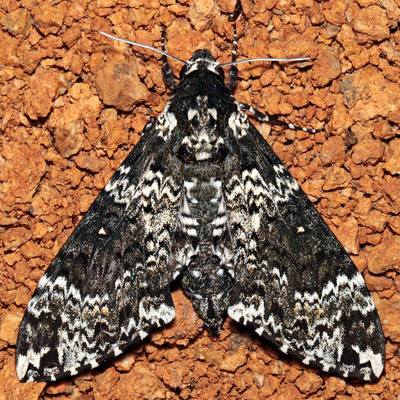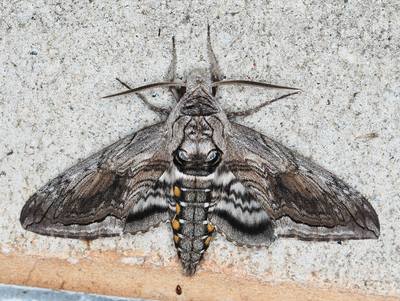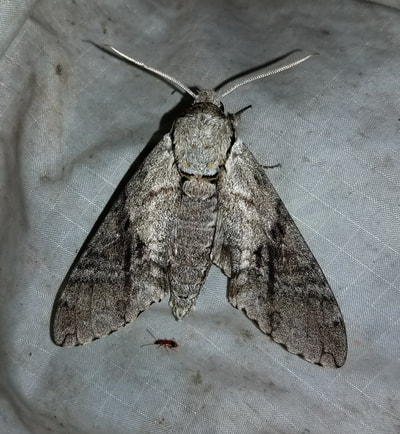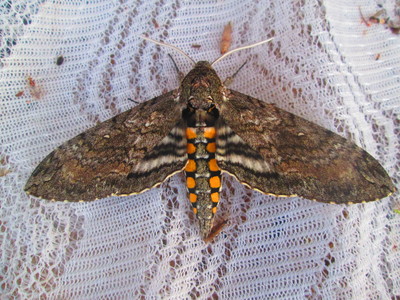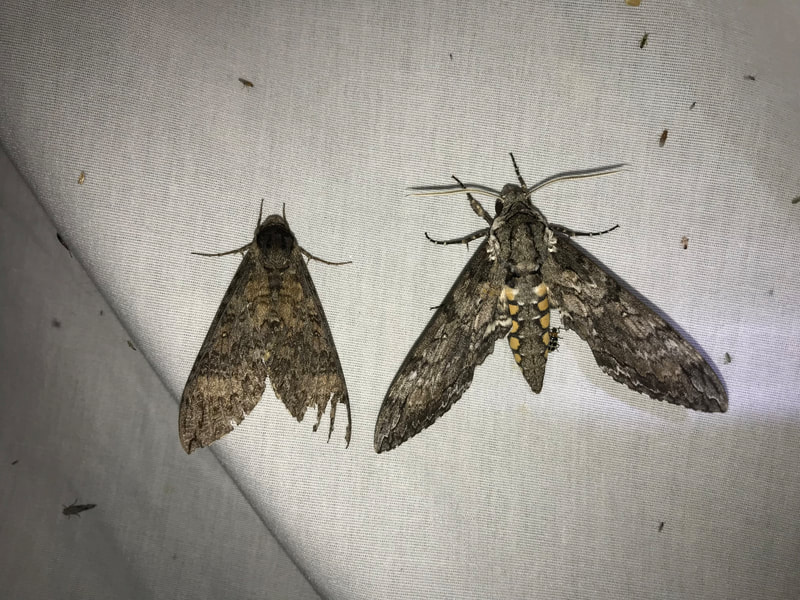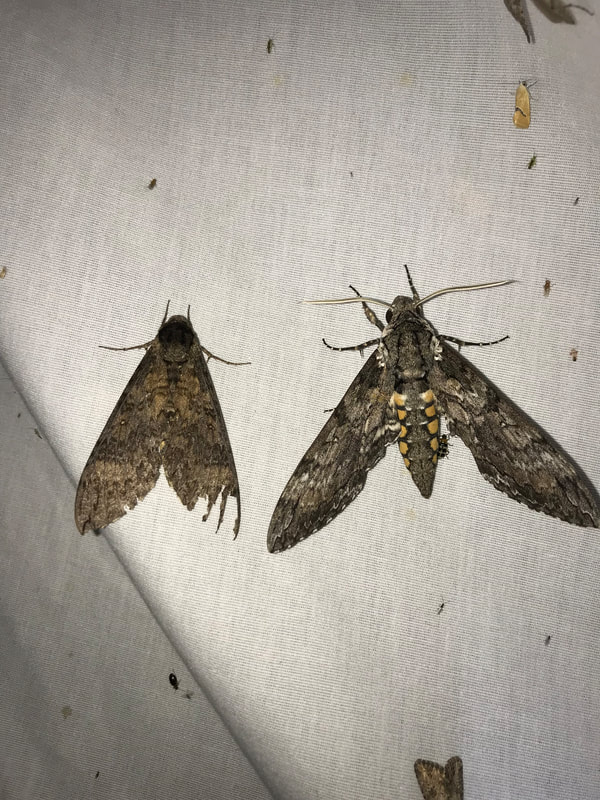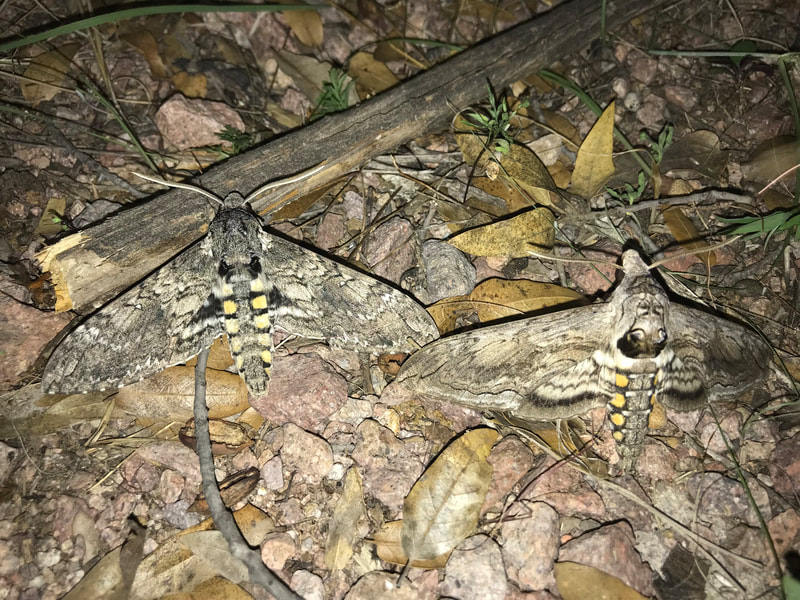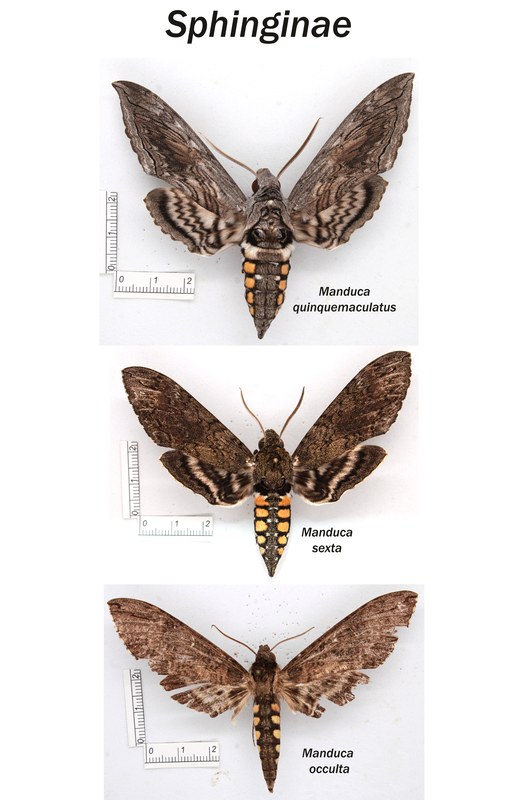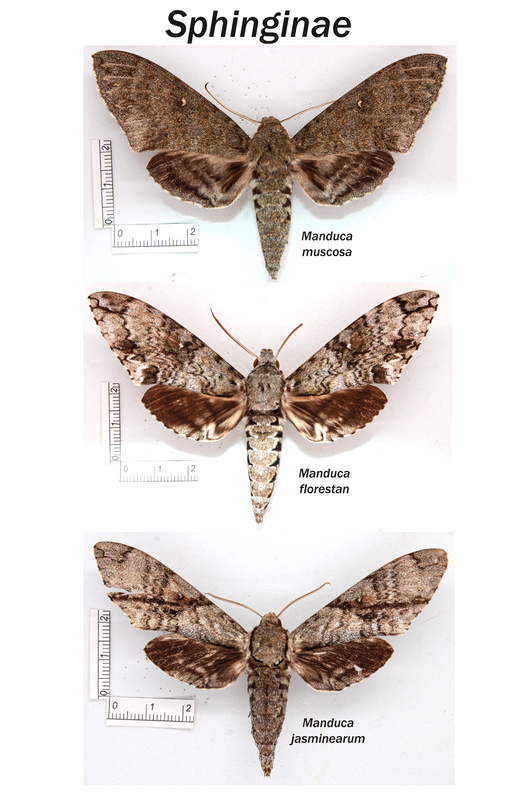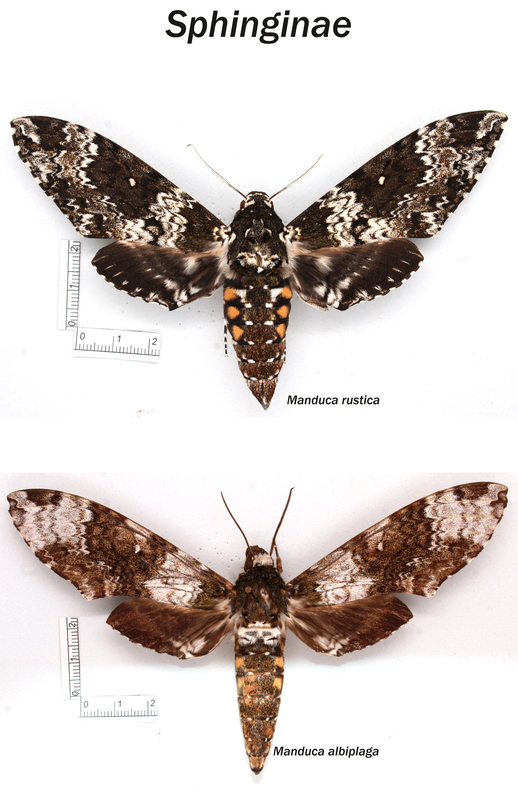The genus Manduca has 10 species in the USA, and about 68 around the world. This is a New-World genus, found only in the Americas.
Type specimen: Sphinx (Manduca) carolina (sexta) -- Linnaeus, 1764 (originally described as Sphinx sexta in 1763)
Synonyms: N/A
General Information: These are medium to large moths, most have mottled forewings of various coloration.
If you have narrowed something down to this genus, you can use this key to help you narrow down your search to species:
1: The abdomen has several pairs of yellow spots (2)
1’: The abdomen has no spotting, or spotting of another color (6)
2: Forewing is deep chocolatey brown with a white discal spot. The area surrounding the discal area is streaked with white, and in the brown area around the discal spot, there are black lines. The submarginal area of the wing is well marked with white and light brown streaking. The abdomen usually only has 3 pairs of yellow spots… Manduca rustica
2’: Not as above (3)
3: Forewing black in the discal area and white in the apex and right after the anal angle. A very large moth that is overall gray rather than brown. 3 yellow spots can be found on the abdomen. The abdomen has a tuft of white scales before these spots. A rare stray… Manduca albiplaga
3’: Not as above
4: Forewing gray with many black streaks. The hindwing is gray with several serrated black bands. The abdomen usually only has 5 pairs of yellow spots... Manduca quinquemaculatus
4’: Not as above (5)
5: The forewings are generally gray-brown with a white discal spot that may be reduced. The fringe of the forewing is checkered unevenly with black/white. The hindwings are gray with several transverse bands of black and one very white streak that runs from the anal angle toward the outer margin. The abdomen usually has 6 pairs of yellow spots… Manduca sexta
5’: The forewings are distinctly brown. The fringe is checkered evenly with black/white. There is a dark patch on the thorax. The hindwings are gray with some black/white transverse lines, less distinctively marked. The abdomen usually has 6 pairs of yellow spots… Manduca occulta
6: There is distinctive black/white checkering on the abdomen. The forewings are gray with a greenish tint and are generally unmarked and smooth in appearance. There is a small white discal spot… Manduca muscosa
6’: Not as above (7)
7: The forewings are gray and tend to have black striations. There is a white discal spot. There may be slightly darker coloration in the area surrounding the discal spot, but the region from the top of the discal spot to the costal edge is the same color as the rest of the wings. There are 4 pairs of white markings on the abomden… Manduca florestan
7’: Not as above (8)
8: The abdomen is plain in color and may have a few pairs of creamy spots. The forewings are gray with a distinctive black streak. The discal area is often brown… Manduca jasminearum
8’: Not as above, the abdomen is generally unmarked (9)
9: Forewings are gray-brown with some black striations. There is a white discal spot…. Manduca brontes cubensis
9’: Forewings gray with a darker region around the discal spot. This is a rare stray… Manduca lanuginosa
Species List:
Manduca sexta
Manduca quinquemaculatus
Manduca rustica
Manduca brontes cubensis
Manduca muscosa
Manduca florestan
Manduca jasminearum
Manduca occulta
Manduca albiplaga
Manduca lanuginosa
The gallery below shows photos of select species in the genus.
Type specimen: Sphinx (Manduca) carolina (sexta) -- Linnaeus, 1764 (originally described as Sphinx sexta in 1763)
Synonyms: N/A
General Information: These are medium to large moths, most have mottled forewings of various coloration.
If you have narrowed something down to this genus, you can use this key to help you narrow down your search to species:
1: The abdomen has several pairs of yellow spots (2)
1’: The abdomen has no spotting, or spotting of another color (6)
2: Forewing is deep chocolatey brown with a white discal spot. The area surrounding the discal area is streaked with white, and in the brown area around the discal spot, there are black lines. The submarginal area of the wing is well marked with white and light brown streaking. The abdomen usually only has 3 pairs of yellow spots… Manduca rustica
2’: Not as above (3)
3: Forewing black in the discal area and white in the apex and right after the anal angle. A very large moth that is overall gray rather than brown. 3 yellow spots can be found on the abdomen. The abdomen has a tuft of white scales before these spots. A rare stray… Manduca albiplaga
3’: Not as above
4: Forewing gray with many black streaks. The hindwing is gray with several serrated black bands. The abdomen usually only has 5 pairs of yellow spots... Manduca quinquemaculatus
4’: Not as above (5)
5: The forewings are generally gray-brown with a white discal spot that may be reduced. The fringe of the forewing is checkered unevenly with black/white. The hindwings are gray with several transverse bands of black and one very white streak that runs from the anal angle toward the outer margin. The abdomen usually has 6 pairs of yellow spots… Manduca sexta
5’: The forewings are distinctly brown. The fringe is checkered evenly with black/white. There is a dark patch on the thorax. The hindwings are gray with some black/white transverse lines, less distinctively marked. The abdomen usually has 6 pairs of yellow spots… Manduca occulta
6: There is distinctive black/white checkering on the abdomen. The forewings are gray with a greenish tint and are generally unmarked and smooth in appearance. There is a small white discal spot… Manduca muscosa
6’: Not as above (7)
7: The forewings are gray and tend to have black striations. There is a white discal spot. There may be slightly darker coloration in the area surrounding the discal spot, but the region from the top of the discal spot to the costal edge is the same color as the rest of the wings. There are 4 pairs of white markings on the abomden… Manduca florestan
7’: Not as above (8)
8: The abdomen is plain in color and may have a few pairs of creamy spots. The forewings are gray with a distinctive black streak. The discal area is often brown… Manduca jasminearum
8’: Not as above, the abdomen is generally unmarked (9)
9: Forewings are gray-brown with some black striations. There is a white discal spot…. Manduca brontes cubensis
9’: Forewings gray with a darker region around the discal spot. This is a rare stray… Manduca lanuginosa
Species List:
Manduca sexta
Manduca quinquemaculatus
Manduca rustica
Manduca brontes cubensis
Manduca muscosa
Manduca florestan
Manduca jasminearum
Manduca occulta
Manduca albiplaga
Manduca lanuginosa
The gallery below shows photos of select species in the genus.
